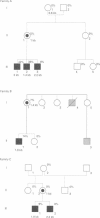Abstract
The probe StB12.3 has been used to screen the FMR-1 gene in 42 pedigrees with a distal Xq fragile site for expansion of the CCG repeat and aberrant methylation of the FRAXA locus. Four families did not have a FRAXA mutation and were investigated further. Fluorescent in situ hybridisation (FISH) and molecular analyses showed that three of these families had an expansion at FRAXE and one at FRAXE. Detailed psychiatric, psychological, and behavioural features of three families with FRAXE identified in the study are presented. All the males who expressed FRAXE had a large methylated CCG repeat at FRAXF. All males with the mutation had some degree of mental handicap. This study illustrates the need for the FRAXE phenotype to be defined further.
Full text
PDF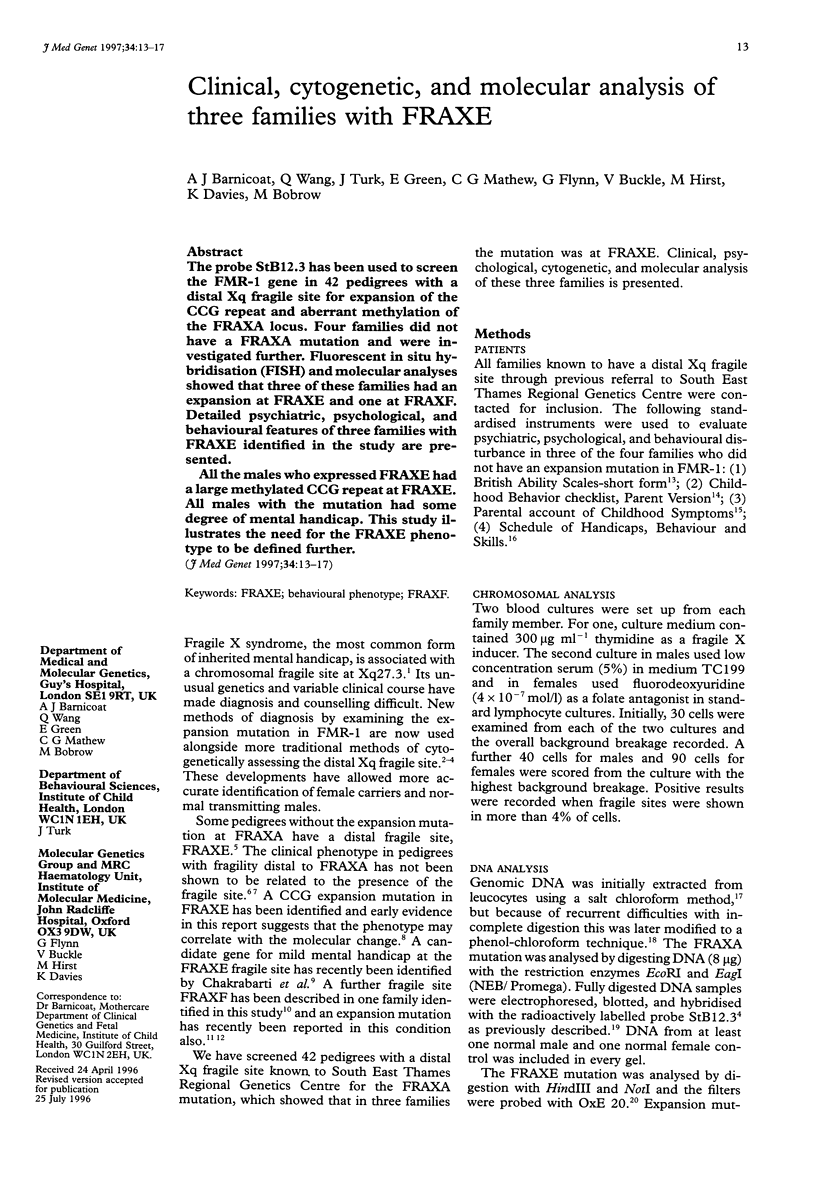
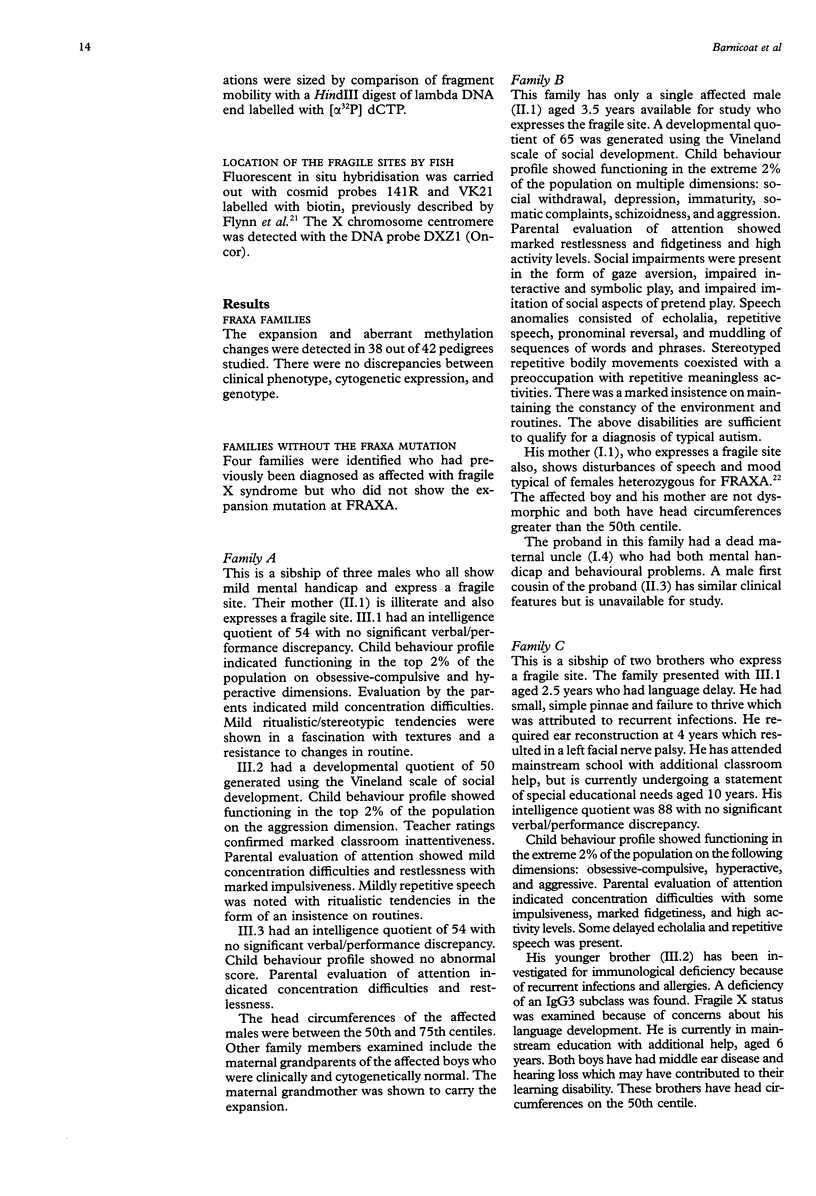
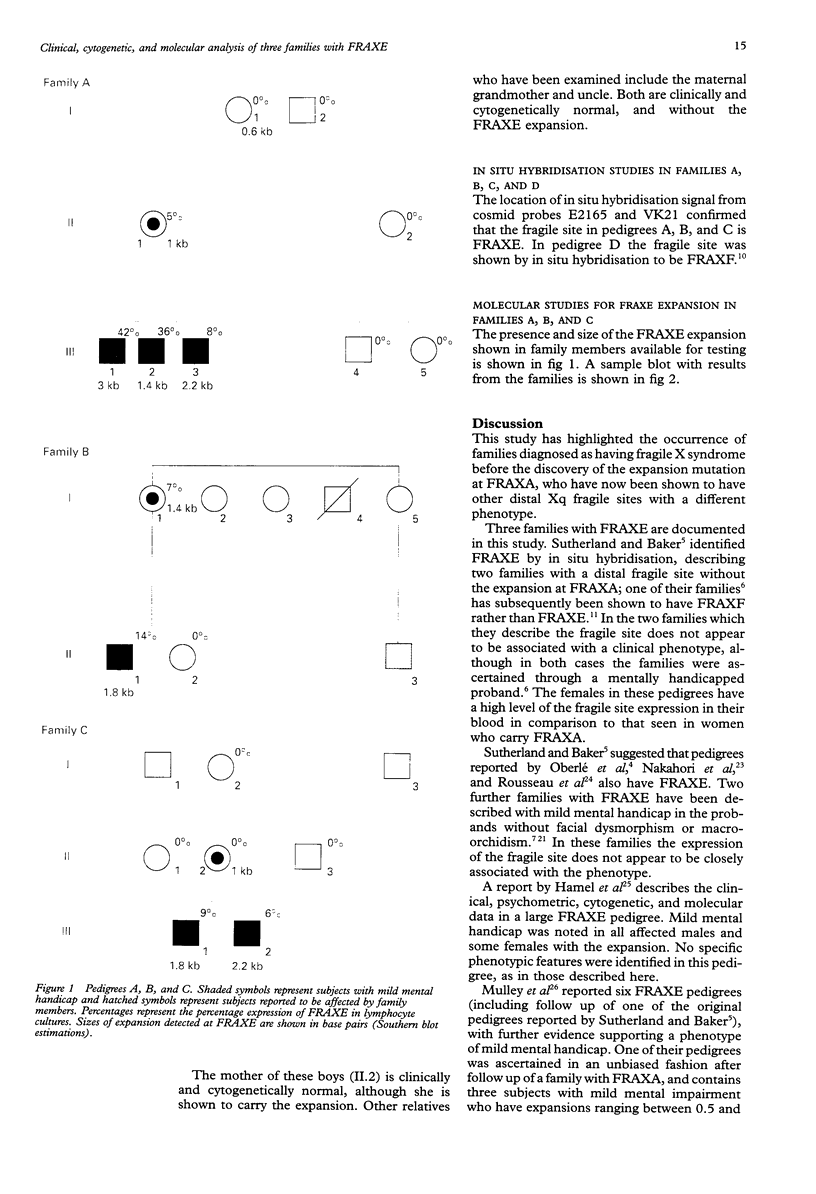
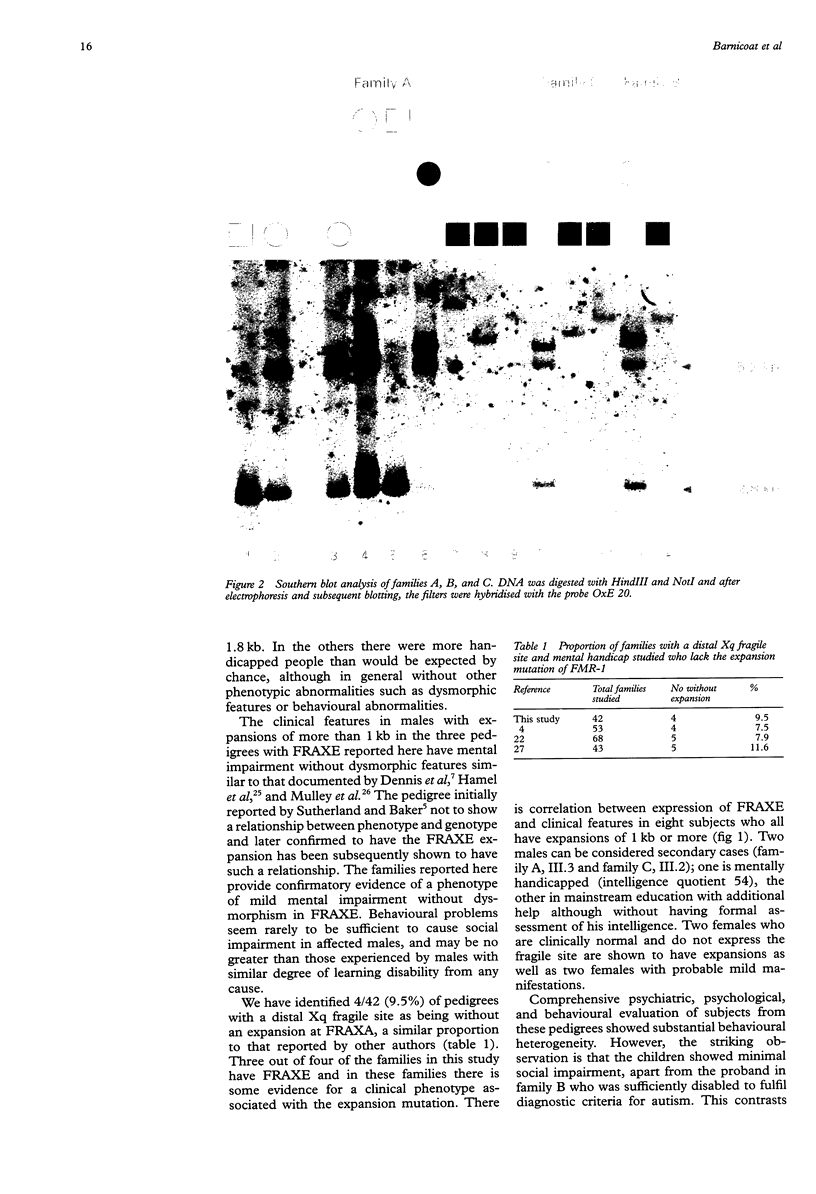
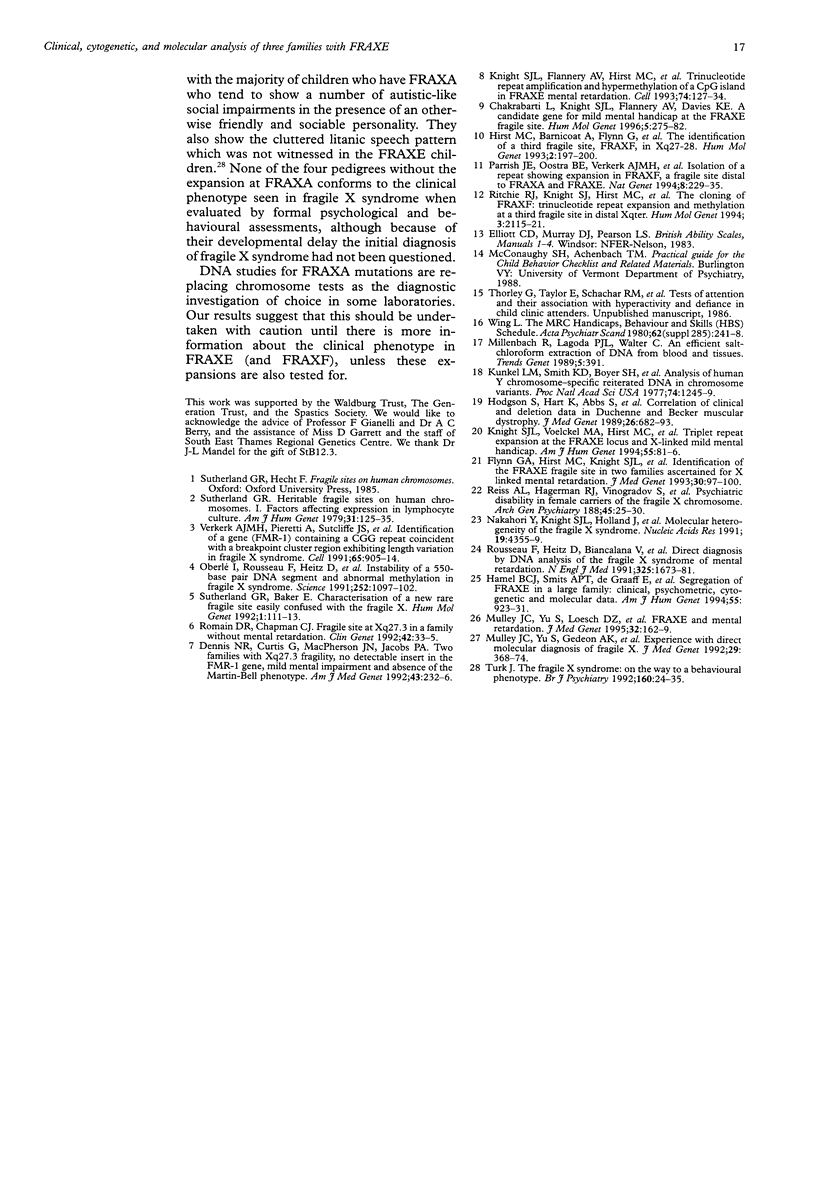
Images in this article
Selected References
These references are in PubMed. This may not be the complete list of references from this article.
- Chakrabarti L., Knight S. J., Flannery A. V., Davies K. E. A candidate gene for mild mental handicap at the FRAXE fragile site. Hum Mol Genet. 1996 Feb;5(2):275–282. doi: 10.1093/hmg/5.2.275. [DOI] [PubMed] [Google Scholar]
- Dennis N. R., Curtis G., Macpherson J. N., Jacobs P. A. Two families with Xq27.3 fragility, no detectable insert in the FMR-1 gene, mild mental impairment, and absence of the Martin-Bell phenotype. 1992 Apr 15-May 1Am J Med Genet. 43(1-2):232–236. doi: 10.1002/ajmg.1320430137. [DOI] [PubMed] [Google Scholar]
- Flynn G. A., Hirst M. C., Knight S. J., Macpherson J. N., Barber J. C., Flannery A. V., Davies K. E., Buckle V. J. Identification of the FRAXE fragile site in two families ascertained for X linked mental retardation. J Med Genet. 1993 Feb;30(2):97–100. doi: 10.1136/jmg.30.2.97. [DOI] [PMC free article] [PubMed] [Google Scholar]
- Hamel B. C., Smits A. P., de Graaff E., Smeets D. F., Schoute F., Eussen B. H., Knight S. J., Davies K. E., Assman-Hulsmans C. F., Oostra B. A. Segregation of FRAXE in a large family: clinical, psychometric, cytogenetic, and molecular data. Am J Hum Genet. 1994 Nov;55(5):923–931. [PMC free article] [PubMed] [Google Scholar]
- Hirst M. C., Barnicoat A., Flynn G., Wang Q., Daker M., Buckle V. J., Davies K. E., Bobrow M. The identification of a third fragile site, FRAXF, in Xq27--q28 distal to both FRAXA and FRAXE. Hum Mol Genet. 1993 Feb;2(2):197–200. doi: 10.1093/hmg/2.2.197. [DOI] [PubMed] [Google Scholar]
- Hodgson S., Hart K., Abbs S., Heckmatt J., Rodillo E., Bobrow M., Dubowitz V. Correlation of clinical and deletion data in Duchenne and Becker muscular dystrophy. J Med Genet. 1989 Nov;26(11):682–693. doi: 10.1136/jmg.26.11.682. [DOI] [PMC free article] [PubMed] [Google Scholar]
- Knight S. J., Flannery A. V., Hirst M. C., Campbell L., Christodoulou Z., Phelps S. R., Pointon J., Middleton-Price H. R., Barnicoat A., Pembrey M. E. Trinucleotide repeat amplification and hypermethylation of a CpG island in FRAXE mental retardation. Cell. 1993 Jul 16;74(1):127–134. doi: 10.1016/0092-8674(93)90300-f. [DOI] [PubMed] [Google Scholar]
- Knight S. J., Voelckel M. A., Hirst M. C., Flannery A. V., Moncla A., Davies K. E. Triplet repeat expansion at the FRAXE locus and X-linked mild mental handicap. Am J Hum Genet. 1994 Jul;55(1):81–86. [PMC free article] [PubMed] [Google Scholar]
- Kunkel L. M., Smith K. D., Boyer S. H., Borgaonkar D. S., Wachtel S. S., Miller O. J., Breg W. R., Jones H. W., Jr, Rary J. M. Analysis of human Y-chromosome-specific reiterated DNA in chromosome variants. Proc Natl Acad Sci U S A. 1977 Mar;74(3):1245–1249. doi: 10.1073/pnas.74.3.1245. [DOI] [PMC free article] [PubMed] [Google Scholar]
- Mulley J. C., Yu S., Gedeon A. K., Donnelly A., Turner G., Loesch D., Chapman C. J., Gardner R. J., Richards R. I., Sutherland G. R. Experience with direct molecular diagnosis of fragile X. J Med Genet. 1992 Jun;29(6):368–374. doi: 10.1136/jmg.29.6.368. [DOI] [PMC free article] [PubMed] [Google Scholar]
- Mulley J. C., Yu S., Loesch D. Z., Hay D. A., Donnelly A., Gedeon A. K., Carbonell P., López I., Glover G., Gabarrón I. FRAXE and mental retardation. J Med Genet. 1995 Mar;32(3):162–169. doi: 10.1136/jmg.32.3.162. [DOI] [PMC free article] [PubMed] [Google Scholar]
- Müllenbach R., Lagoda P. J., Welter C. An efficient salt-chloroform extraction of DNA from blood and tissues. Trends Genet. 1989 Dec;5(12):391–391. [PubMed] [Google Scholar]
- Nakahori Y., Knight S. J., Holland J., Schwartz C., Roche A., Tarleton J., Wong S., Flint T. J., Froster-Iskenius U., Bentley D. Molecular heterogeneity of the fragile X syndrome. Nucleic Acids Res. 1991 Aug 25;19(16):4355–4359. doi: 10.1093/nar/19.16.4355. [DOI] [PMC free article] [PubMed] [Google Scholar]
- Parrish J. E., Oostra B. A., Verkerk A. J., Richards C. S., Reynolds J., Spikes A. S., Shaffer L. G., Nelson D. L. Isolation of a GCC repeat showing expansion in FRAXF, a fragile site distal to FRAXA and FRAXE. Nat Genet. 1994 Nov;8(3):229–235. doi: 10.1038/ng1194-229. [DOI] [PubMed] [Google Scholar]
- Ritchie R. J., Knight S. J., Hirst M. C., Grewal P. K., Bobrow M., Cross G. S., Davies K. E. The cloning of FRAXF: trinucleotide repeat expansion and methylation at a third fragile site in distal Xqter. Hum Mol Genet. 1994 Dec;3(12):2115–2121. doi: 10.1093/hmg/3.12.2115. [DOI] [PubMed] [Google Scholar]
- Romain D. R., Chapman C. J. Fragile site Xq27.3 in a family without mental retardation. Clin Genet. 1992 Jan;41(1):33–35. doi: 10.1111/j.1399-0004.1992.tb03625.x. [DOI] [PubMed] [Google Scholar]
- Rousseau F., Heitz D., Biancalana V., Blumenfeld S., Kretz C., Boué J., Tommerup N., Van Der Hagen C., DeLozier-Blanchet C., Croquette M. F. Direct diagnosis by DNA analysis of the fragile X syndrome of mental retardation. N Engl J Med. 1991 Dec 12;325(24):1673–1681. doi: 10.1056/NEJM199112123252401. [DOI] [PubMed] [Google Scholar]
- Sutherland G. R., Baker E. Characterisation of a new rare fragile site easily confused with the fragile X. Hum Mol Genet. 1992 May;1(2):111–113. doi: 10.1093/hmg/1.2.111. [DOI] [PubMed] [Google Scholar]
- Sutherland G. R. Heritable fragile sites on human chromosomes I. Factors affecting expression in lymphocyte culture. Am J Hum Genet. 1979 Mar;31(2):125–135. [PMC free article] [PubMed] [Google Scholar]
- Turk J. The fragile-X syndrome. On the way to a behavioural phenotype. Br J Psychiatry. 1992 Jan;160:24–35. doi: 10.1192/bjp.160.1.24. [DOI] [PubMed] [Google Scholar]
- Verkerk A. J., Pieretti M., Sutcliffe J. S., Fu Y. H., Kuhl D. P., Pizzuti A., Reiner O., Richards S., Victoria M. F., Zhang F. P. Identification of a gene (FMR-1) containing a CGG repeat coincident with a breakpoint cluster region exhibiting length variation in fragile X syndrome. Cell. 1991 May 31;65(5):905–914. doi: 10.1016/0092-8674(91)90397-h. [DOI] [PubMed] [Google Scholar]



